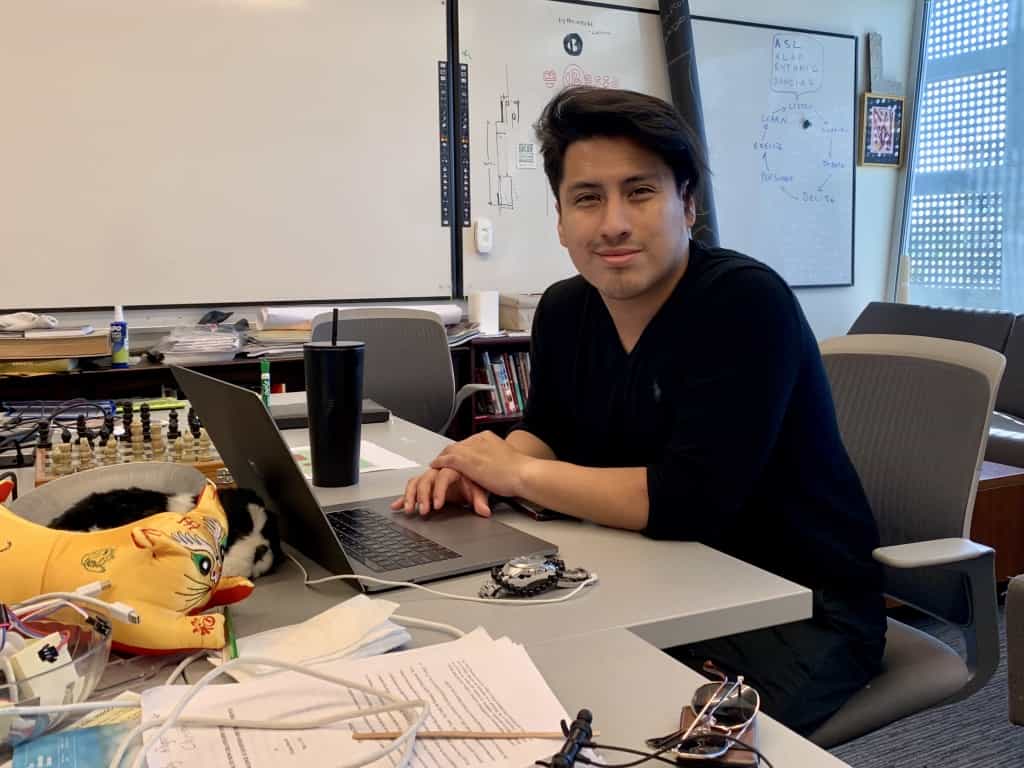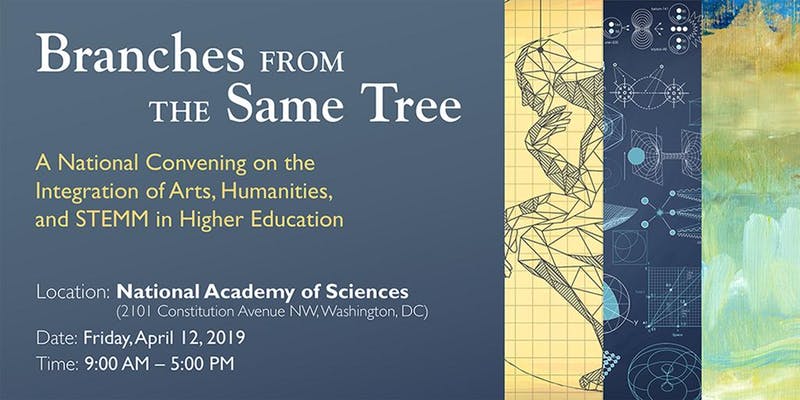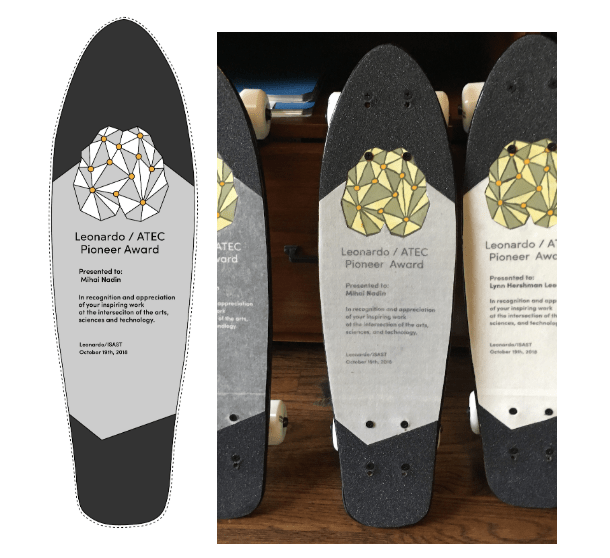Three weeks before the Leonardo Journal’s 50th anniversary, Roger Malina commissioned Twin Boards to create custom skateboards to give away as awards. The recipients included three significant contributors to the Leonardo journal: Linda Henderson, Lynn Herschmann, and Mihai Nadin. For each of the award-boards, Twin Boards co-founder and Artscilab member Jacob Hunwick and his twin brother Cason Hunwick created personalized skateboards based on each artists body of work.
For ease of presentation and transport a 22-inch deck size decided on. The decks were designed and hand built by Twin Boards. Previous to this commission, the brothers have designed and painted 40 custom skateboards.
The top of each board features a custom grip tape design incorporating the Leonardo brain logo, an inscription, and the name of the recipient. To avoid having to hand paint the inscriptions, each body of text was printed out and adhered to the back of clear grip tape. This process unified the printed text with the rest of the board.
Award-Board Design 1
a longboard proclaiming its worth to its owner. Leader of a computation research lab at ATEC at UT Dallas, Professor Mihai Nadin works to understand how computers might be able to anticipate. In an interview with Ubiquity [1] Nadin explains anticipation in terms of an automobile “a car is much more than a large metal object, it is an instrument of my purpose from getting from point A to point B”. Similar to a car, a longboard can assist in movement between locations. To encapsulate this similarity and turn the proposition on its head, Nadin’s skateboard proclaims “I am more than just a wooden plank, I am an instrument of your purpose” proclaiming its worth by Nadin’s own terms.
 Nadins board features a painted depiction of a famous Henri-Cartier Bresson photograph depicting motion [2]. The photograph represents anticipation, a key concept in Nadin’s work.
Nadins board features a painted depiction of a famous Henri-Cartier Bresson photograph depicting motion [2]. The photograph represents anticipation, a key concept in Nadin’s work.

Award-Board Design 2
Adding to the art-history of the fourth dimension. Professor and author Linda Henderson studies the art history of the 4th dimension. In her studies, she uncovers a wide range of attempts to visualize extra dimensions. Naturally humans have no faculty for understanding another special direction. Nevertheless, artists and scientists alike have attempted to conceptualize this physical reality since it was referred to as ‘the Ether’ [3]. Rather than document previous works, Henderson’s board is itself another artists attempt to grasp at the concept.

Beneath the unassuming depiction of a cube are lines of magnetic paint that connect to form a tesseract. Wielding a magnet, the beholder closes their eyes and probes the board and feels the magnetic paint guiding them along each line. Fully explored and plotted, the invisible lines connect with the visible cube to create a 4 dimensional cube, known as a tesseract.

Award-Board design 3
An extra ear in the room. Renowned multi-media artist Lynn Herschman Leeson explores topics in surveillance and artificial intelligence. Her board synthesizes these topics pairing a recording device with Hershman’s AI chatbot Agent Ruby [4]. Just as it appears on the interactive website, Ruby’s red lips and eyes stand out against a white background and light up when the red recording light comes on. The recording device references Hershman’s installment Vertighost in which two galleries are linked via video feed captured through cameras in the eyes of a figure in a painting [5].


For the presentation ceremony, Jacob Hunwick along with five other students rode longboards onto the stage and handed out the boards.
Each recipient was delighted with the conceptual ideas behind the boards and their final appearance. Linda Henderson described her board “as an original contribution to the discourse of art history” while Lynn Herschman and Mihai Nadin were both intrigued by the audio elements.
Image credits: Jacob Hunwick
Thanks to: Cason Hunwick (carpenter & designer)
Resources:
[1] https://ubiquity.acm.org/article.cfm?id=1046683
[2] https://pro.magnumphotos.com/C.aspx?VP3=CMS3&VF=MAGO31_10_VForm&ERID=24KL53ZMYN
[3] Linda Henderson The Fourth Dimension and Non-Euclidean Geometry.
[4] http://agentruby.sfmoma.org/
[5] https://www.vertighost.net/





 Nadins board features a painted depiction of a famous Henri-Cartier Bresson photograph depicting motion [2]. The photograph represents anticipation, a key concept in Nadin’s work.
Nadins board features a painted depiction of a famous Henri-Cartier Bresson photograph depicting motion [2]. The photograph represents anticipation, a key concept in Nadin’s work.




